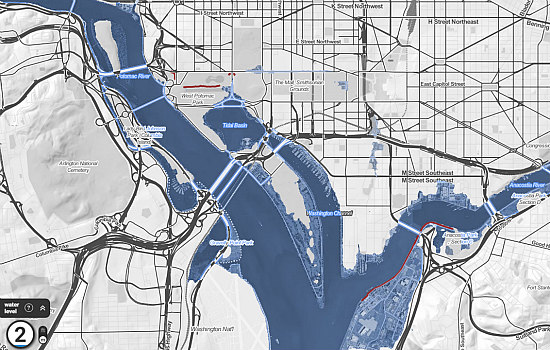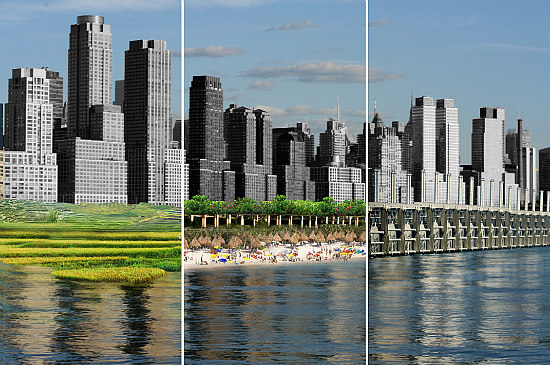 How DC Can Rise to the Challenges of Climate Change
How DC Can Rise to the Challenges of Climate Change
✉️ Want to forward this article? Click here.

A map showing DC’s sea levels in 2100 due to Antarctic glacial melting
The District is not immune from the effects of climate change and a panel on Tuesday night discussed how the city is responding to mounting environmental concerns.
The panel, moderated by former Ward 6 councilmember Tommy Wells, offered a reality check on climate change, its likely impact in the District and what is being done to prevent the worst from happening. The overall takeaway for the evening was that different cities and localities need to partner together to come up with bold and creative solutions to diminish the impact of climate change on the most vulnerable people and neighborhoods.
Wells noted that DC’s location — situated between two tidal rivers and on top of a tectonic plate — means that the city is gradually sinking even as sea levels rise. Even though the city is currently implementing its Sustainable DC plan, involving several benchmarks and timelines aimed at reducing emissions, additional steps need to be taken in order to prepare the city for the inevitable effects of climate change.
story continues below
loading...story continues above
Washington Post Deputy Weather Editor Angela Fritz pointed out that Antarctic glacial melting alone could raise DC-area sea levels by two meters by the year 2100. In light of such sobering information, the city is drafting a climate adaptation plan which will assess and address its infrastructure and neighborhood vulnerability, as well as identify what lies within the floodplains.
DC’s former head of the Office of Planning Harriet Tregoning, now with the Department of Housing and Urban Development, offered a perspective on the nationwide and local responses to climate change. There were 208 declared disasters in the U.S. between 2011 and 2013, and while most funding goes toward restoring impacted areas, Tregoning’s office set aside $1 billion at the end of 2013 for the National Disaster Resilience Competition (NDRC). The contest offered an opportunity for disaster-affected localities to develop solutions to not only rebuild, but to do so in such a way that future vulnerabilities are mitigated against. HUD announced the winners of the contest this past January.

A winning NDRC design for a New York City park that will mitigate rising sea levels
Another area of concern is the disproportionate impact of extreme weather and environmental instability on poorer households. Tregoning pointed out that the benefits of renewable energy have largely been inequitable thus far, and poor people pay more for utilities.
Wells explained that up to 10 percent of the city can support solar panels, but the challenge is to figure out how to maximize the benefits of solar power for low-income residents. Towards that end, the city is spending $25 million over 24 months to invest in solar energy, and solar panels will be installed on DC government buildings (which already receive 30 percent of their energy from a Pennsylvania wind farm).
Ultimately, the takeaway from the evening was that cities need to experiment and find solutions that can address impending climate change, the need for improved and expanded transit, and underemployment. While Tregoning jokingly asked, “don’t you think the monuments would be beautiful by gondola?”, the fact remains that these are the kinds of bold proposals that can become effective solutions.
See other articles related to: climate change, hud, planning
This article originally published at https://dc.urbanturf.com/articles/blog/how_dc_can_rise_to_the_challenges_of_climate_change/11130.
Most Popular... This Week • Last 30 Days • Ever

With frigid weather hitting the region, these tips are important for homeowners to ke... read »

Today, UrbanTurf offers a brief explanation of what it means to lock in an interest r... read »

A new report from DC’s Office of Revenue Analysis highlights how millennials and wo... read »

An application extending approval of Friendship Center, a 310-unit development along ... read »

The 30,000 square-foot home along the Potomac River sold at auction on Thursday night... read »
DC Real Estate Guides
Short guides to navigating the DC-area real estate market
We've collected all our helpful guides for buying, selling and renting in and around Washington, DC in one place. Start browsing below!
First-Timer Primers
Intro guides for first-time home buyers
Unique Spaces
Awesome and unusual real estate from across the DC Metro














